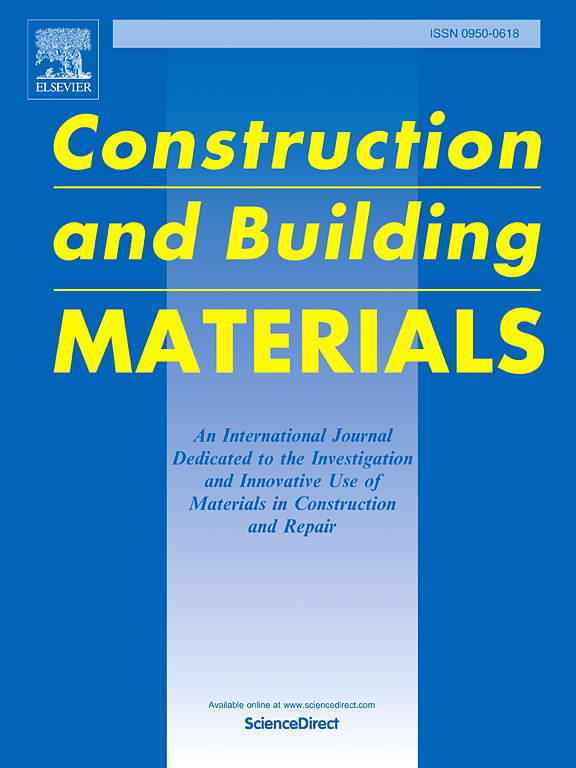Detection method of shallow freeze-thaw damage in asphalt mixture based on infrared pulse thermography
IF 7.4
1区 工程技术
Q1 CONSTRUCTION & BUILDING TECHNOLOGY
引用次数: 0
Abstract
Freeze-thaw damage to the asphalt mixture is considered to be one of the primary underlying causes of pavement defects. Nevertheless, the current lack of appropriate evaluation equipment and methodologies impedes the accurate assessment of the degree of freeze-thaw damage in real time, directly affecting the formulation of pavement maintenance decisions. Infrared thermography technology facilitates the detection of superficial freeze-thaw damage in asphalt pavements. In this paper, a detection system of shallow freeze-thaw damage in asphalt mixtures based on infrared pulse thermography is established. Infrared characteristic parameters are extracted from the aspect of temperature gradients. Temperature contours, local temperature gradients (LTG), and comprehensive temperature gradients (CTG) are utilized to analyze the temperature field distribution of asphalt mixtures. A detection method for the freeze-thaw damage point of asphalt mixtures is proposed, and the correlation between infrared characteristic parameters and the mechanical properties of the specimens is analyzed. Based on the infrared phase-locked thermography system, the effectiveness and applicability of the detection method are verified, with the comprehensive phase gradient (CPG) serving as the characteristic index. The results indicate that CTG can better reflect the surface temperature difference area of the single-sided freeze-thaw specimen. The CTG of the specimen in the normal state is relatively minor and concentrated below 0.3. The correlation characteristics between the CTG characteristic parameters and the freeze-thaw splitting strength ratio (TSR)were analyzed. The critical values of the proportions of high gradient areas u0.2 and u0.3 are 0.19 and 0.04 respectively. When the critical values are exceeded, it can be concluded that the asphalt mixture has damage as a result of freeze-thaw. The correlation coefficient between the parameters of the CTG and the CPG is above 0.85, indicating a strong correlation between both variables. The detection method proposed in this article provides a new idea for realizing in-situ non-destructive shallow damage detection of pavements and also provides a foundation for transportation infrastructure construction and road maintenance decisions based on infrared thermography.
基于红外脉冲热成像的沥青混合料浅冻融损伤检测方法
冻融损伤沥青混合料被认为是路面缺陷的主要潜在原因之一。然而,目前缺乏适当的评估设备和方法,阻碍了对冻融破坏程度的实时准确评估,直接影响了路面养护决策的制定。红外热成像技术有助于沥青路面表面冻融损伤的检测。本文建立了一种基于红外脉冲热成像的沥青混合料浅层冻融损伤检测系统。从温度梯度的角度提取红外特征参数。利用温度等高线、局部温度梯度(LTG)和综合温度梯度(CTG)分析沥青混合料的温度场分布。提出了一种沥青混合料冻融损伤点检测方法,分析了红外特征参数与试件力学性能的相关性。基于红外锁相热成像系统,以综合相位梯度(CPG)作为特征指标,验证了该检测方法的有效性和适用性。结果表明,CTG能较好地反映单面冻融试件的表面温差面积。正常状态下试样CTG相对较小,集中在0.3以下。分析了CTG特征参数与冻融劈裂强度比(TSR)的相关特征。高梯度区比例临界值u0.2和u0.3分别为0.19和0.04。当超过临界值时,可判定沥青混合料因冻融作用而发生损伤。CTG参数与CPG参数的相关系数在0.85以上,表明两者之间存在较强的相关性。本文提出的检测方法为实现路面的原位无损浅损检测提供了新的思路,也为基于红外热像仪的交通基础设施建设和道路养护决策提供了依据。
本文章由计算机程序翻译,如有差异,请以英文原文为准。
求助全文
约1分钟内获得全文
求助全文
来源期刊

Construction and Building Materials
工程技术-材料科学:综合
CiteScore
13.80
自引率
21.60%
发文量
3632
审稿时长
82 days
期刊介绍:
Construction and Building Materials offers an international platform for sharing innovative and original research and development in the realm of construction and building materials, along with their practical applications in new projects and repair practices. The journal publishes a diverse array of pioneering research and application papers, detailing laboratory investigations and, to a limited extent, numerical analyses or reports on full-scale projects. Multi-part papers are discouraged.
Additionally, Construction and Building Materials features comprehensive case studies and insightful review articles that contribute to new insights in the field. Our focus is on papers related to construction materials, excluding those on structural engineering, geotechnics, and unbound highway layers. Covered materials and technologies encompass cement, concrete reinforcement, bricks and mortars, additives, corrosion technology, ceramics, timber, steel, polymers, glass fibers, recycled materials, bamboo, rammed earth, non-conventional building materials, bituminous materials, and applications in railway materials.
 求助内容:
求助内容: 应助结果提醒方式:
应助结果提醒方式:


